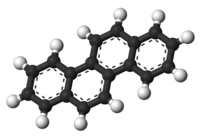- Chrysene
-
Chrysene[1] 
 ChryseneOther namesBenzo[a]phenanthrene
ChryseneOther namesBenzo[a]phenanthrene
1,2-BenzphenanthreneIdentifiers CAS number 218-01-9 
PubChem 10457109 ChemSpider 8817 
UNII 084HCM49PT 
EC number 205-923-4 KEGG C14222 
ChEBI CHEBI:51687 
ChEMBL CHEMBL85685 
RTECS number GC0700000 Jmol-3D images Image 1 - c1ccc2c(c1)ccc3c2ccc4c3cccc4
Properties Molecular formula C18H12 Molar mass 228.28 Appearance Orthorhombic bipyramidal plates Density 1.274 g/cm3 Melting point 254 °C, 527 K, 489 °F
Boiling point 448 °C, 721 K, 838 °F
Solubility in water Insoluble Solubility in Ethanol 1 mg/1300 mL Related compounds Related PAHs Pyrene, Tetracene, Triphenylene  (verify) (what is:
(verify) (what is:  /
/ ?)
?)
Except where noted otherwise, data are given for materials in their standard state (at 25 °C, 100 kPa)Infobox references Chrysene is a polycyclic aromatic hydrocarbon (PAH) with the molecular formula C18H12 that consists of four fused benzene rings. It is a natural constituent of coal tar, from which it was first isolated and characterized. It is also found in creosote, a chemical used to preserve wood.
Chrysene is formed in small amounts during the burning or distillation of coal, crude oil, and plant material.
The name "chrysene" originates from Greek Χρύσoς (chrysos), meaning "gold", and is due to the golden-yellow color of the crystals of the hydrocarbon, thought to be the proper color of the compound at the time of its isolation and characterization. However, high purity chrysene is colorless, the yellow hue being due to the traces of its yellow-orange isomer tetracene, which cannot be separated easily.
Use
Chrysene is used in the manufacture of some dyes.
Safety
As with other PAHs, chrysene is suspected to be a human carcinogen. It is known to cause cancer in laboratory animals.[2]
References
- ^ Merck Index, 11th Edition, 2259.
- ^ TOXICOLOGICAL PROFILE FOR POLYCYCLIC AROMATIC HYDROCARBONS
2 rings 3 rings 4 rings Benz[a]anthracene · Benzo[a]fluorene · Benzo[c]phenanthrene · Chrysene · Fluoranthene · Pyrene · Tetracene · Triphenylene5 rings 6+ rings Anthanthrene · Benzo[ghi]perylene · Corannulene · Coronene · Dicoronylene · Diindenoperylene · Helicene · Heptacene · Hexacene · Kekulene · Ovalene · ZethreneCategories:- Polycyclic aromatic hydrocarbons
- IARC Group 2B carcinogens
Wikimedia Foundation. 2010.
